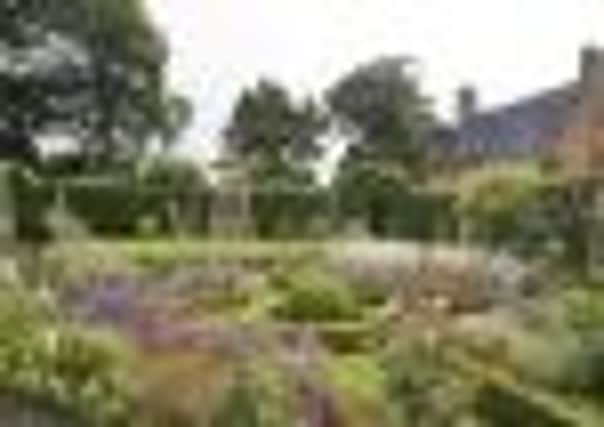Gardens: Liberton House and the beauty of a period garden were waiting for Kelly and Jon Foley when they moved to Scotland from London


They were looking for more open space for their children than was available in London and close proximity to an airport was also a priority.
Not for one minute did the couple imagine they would end up purchasing Liberton House, a 16th-century, A-listed, fortified building, surrounded by an innovative and newly-restored Renaissance garden. Sandwiched between suburbs and fields at the end of a tree-lined drive in south west Edinburgh, the ochre-harled house was just a short drive to the city centre.
Advertisement
Hide AdAdvertisement
Hide Ad“The house found us,” says Kelly. “We had an eye on the market but thought perhaps a weekend or holiday place would suit. And suddenly we heard about Liberton.” Undaunted by being 29 weeks pregnant with her third child and being refused permission to fly at the last minute, Kelly rushed to the station and caught a train to Edinburgh.


“I fell in love with the house instantly,” she recalls. “But the problem was we were not ready to move.” This was overcome when the owners agreed to sell the house and rent it back for a year.” Jon and Kelly moved in 13 months ago.
She and Jon were “stunned by the beauty of the garden, but slightly daunted and lacking in experience”, so they spent the winter just looking out at the layout they had inherited. By the spring, they felt confident enough, with the help of gardener Paul Smith, to take some tentative steps forward.
The history of the house’s restoration is an intriguing one. Devastated by a fire in 1991, Liberton House, the ancestral home of the Gilmour family, was abandoned and on the verge of being demolished and its land transformed into a car park, when it was bought by architects Nicholas Groves-Raines and his wife, Kristín Hannesdóttir. The couple decided to restore the house, in conjunction with the garden. For this they relied on skeletal remains of walls and an old plan that indicated the layout of the ancient privy garden.
To introduce a contemporary note, they were inspired by renowned Scottish gardeners such as architect Charles Jencks and the late poet Ian Hamilton Finlay. The result was a series of connecting spaces surrounding the house: a walled garden, topiary lawn, wild garden and landform. One of their clients, Robert Dalrymple, whose garden at Broadwoodside in East Lothian is widely regarded as one of Scotland’s most innovative gardens, also had an input, notably in the box and topiary detail.


Entered through a side gate, the walled garden opens up into a Renaissance-inspired layout of box parterres packed with colourful perennials, herbs, vegetables and fruit.
The soft palate of old scented roses, including Rosa ‘Reine Victoria’ and ‘Konigen von Denmark’ meld into the salmon pink Rosa ‘Albertine’ on the metal arbour that runs along the central border and over a variety of apple trees.
A wooden gate leads to the topiary lawn where, along the side of the 300-year-old holly hedge, a row of beech buttresses create alcoves for sitting and two rows of simple topiary yew frame the lawn currently in use as a rugby pitch. “It’s right in front of the house so we can see what is going on,” Kelly says.
Advertisement
Hide AdAdvertisement
Hide AdRobert Dalrymple’s touch is evident in the charming box parterre, laid out in the shape of a Saltire, with contrasting silvery santolina and the geometric yew shapes that run along the line of the holly hedge.


Future plans include the introduction of wild flowers into the banks that slope down from the raised path that runs along the southern perimeter of the garden, to the rear of the walled and topiary spaces. In spring there will also be a bigger display of bulbs.
Wild flowers are also planned for the wild garden, where mown paths lead through a paddock of long grass. Here, Hamilton Finlay’s talent for placing architectural features in an informal, tree-punctuated landscape is evident. Paths lead past a grove of Betula Jacquemontii, toward a central stone urn and towards an allée of lime trees that frames both the view out to the Pentland Hills and back to the house. “There is a view from every angle of the garden,” Kelly points out.
A compact hornbeam maze makes an amusing addition and is a source of endless amusement to the Foley children who also enjoy the Charles Jencks-inspired, 12ft tall landform to the rear of the house. Accessed by serpentine paths, it ensures a tour of this garden finishes with a flourish. Shaped from a mound of earth sitting behind the house, it was inspired by Jencks’ work at the Scottish National Gallery of Modern Art in Edinburgh.
Part of the fun of a visit to this charming garden is seeing it enjoyed by a young family. “It is a magical place for a family,” Kelly agrees. “For us it is a steep learning curve. But we will take things slowly and enjoy it.” With the addition of four chickens and a tree house to the garden, it sounds anything but slow.
Robert and Anna Dalrymple’s garden, Broadwoodside, Gifford, EH41 4JQ, is open as part of the Lammermuir Festival on Wednesday (www.broadwoodside.co.uk, www.lammermuirfestival.co.uk)